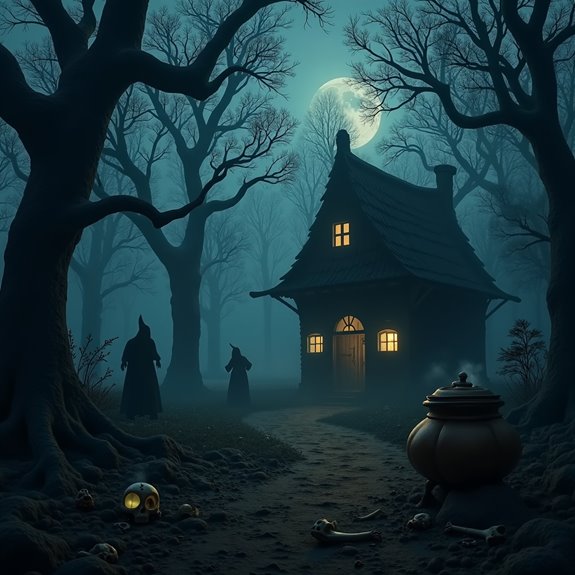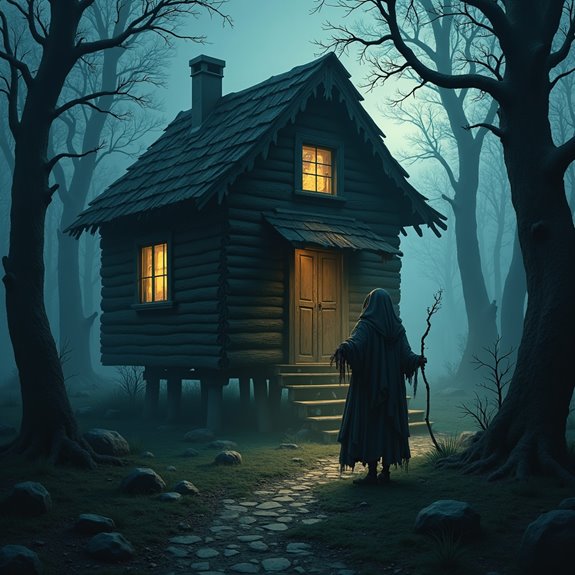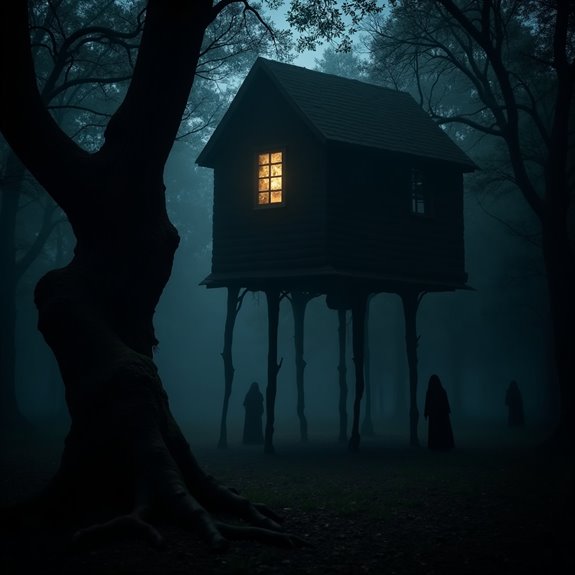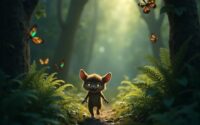The Baba Yaga Archetype in Global Witch Legends
The Baba Yaga archetype is a intriguing figure in global witch legends, enchanting audiences with her dual nature. She embodies both wisdom and fear, challenging protagonists to face their innermost fears. This complex character, with her iconic chicken-legged hut, serves as a bridge between the natural and supernatural domains. As her stories unfold, they reveal deeper insights into cultural perspectives on femininity and personal transformation. But what lies behind her enigmatic presence?
Introduction

Although many cultures feature their own unique representations of witches, the Baba Yaga archetype stands out as a compelling symbol in global witch legends. Associated with Slavic folklore, Baba Yaga embodies duality—both a fearsome hag and a wise, helpful figure. She lives in a hut that spins on chicken legs, instantly enchanting imaginations and highlighting her unconventional nature. More than just a witch, Baba Yaga serves as a guardian of the threshold between life and death, knowledge and ignorance. Her presence challenges heroes and heroines, forcing them to confront fears and discover inner strength. This complexity makes her an enduring figure in folklore, transcending cultural boundaries while inspiring countless stories across the world about the nature of power, wisdom, and transformation.
Eastern European Folklore Roots

While exploring the roots of the Baba Yaga archetype, one finds rich historical connections to Eastern European folklore. This enigmatic figure often emerges as a complex character, straddling the line between nature and civilization. In Slavic myths, she embodies duality, serving as both a nurturing mother and a fearsome witch. Villagers tell tales of her dwelling in a chicken-leg hut, symbolizing her connection with the untamed wilderness. Baba Yaga often interacts with heroes, challenging them through tests of character and resolve. These encounters reflect broader themes of change and morality in human experience. Through centuries, her narratives have evolved, yet the essence of Baba Yaga continues to captivate and inspire stories across cultures, evolving from myth to modern interpretations.
Notable Cases or Sightings

What stories linger in the minds of those who claim to have encountered Baba Yaga? Tales circulate of a young girl who stumbled upon a hut on chicken legs, where the fearsome witch offered a choice: brave her wrath or ask for knowledge. Another story tells of an old man spotting the witch flying through the night sky, an eerie glow surrounding her. Some villagers mention sudden misfortunes following eerie whispers in the woods, which they believe hint at Baba Yaga’s presence. An artist once claimed to catch her likeness in a dream, inspiring a series of haunting paintings. Each encounter adds to the rich tapestry of legends surrounding Baba Yaga, blurring the lines between fear and fascination in folklore.
Common Theories or Explanations
As scholars explore the Baba Yaga archetype, they often turn to common theories that illuminate her role in folklore. One prevailing theory suggests she embodies the dual nature of femininity, representing both nurturing and destructive forces. This complexity reflects societal views on women, often oscillating between reverence and fear. Another theory posits that Baba Yaga symbolizes the shift from childhood to adulthood, guiding individuals through transformative experiences. Scholars also examine her connection to nature and the supernatural, as she resides deep in the woods, bridging the human and mystical domains. Additionally, her indicators of wisdom and cunning challenge traditional power structures, illustrating the wisdom that can reside in the margins of society. Each theory enriches the understanding of Baba Yaga’s multifaceted character.
Frequently Asked Questions
What Are the Common Symbols Associated With Baba Yaga?
Common symbols associated with Baba Yaga include her iron nose, magical flying mortar, broomstick, and the forest. These elements illustrate her connection to nature, magic, and her mysterious, often fearsome, character in folklore.
How Has Baba Yaga Influenced Modern Witchcraft Practices?
Baba Yaga’s tales inspire modern witchcraft practices, blending folklore with personal empowerment. Many witches draw on her wisdom and assertiveness, incorporating her symbols and narratives into rituals, ultimately fostering a deeper connection to nature and mysticism.
Are There Other Similar Archetypes in Different Cultures?
Yes, other cultures have similar archetypes, like Hecate in Greek mythology, who embodies magic and witchcraft, and La Llorona in Latin folklore, representing sorrow and danger. These figures share themes of transformation and power.
What Lessons Can We Learn From Baba Yaga Stories?
Baba Yaga’s stories teach resilience, the importance of wisdom, and the value of facing fears. They highlight the complexity of nature and morality, encouraging individuals to navigate life’s challenges with courage and cunning.
How Do Contemporary Media Portray Baba Yaga?
Contemporary media often portrays Baba Yaga as a complex figure, blending menace and wisdom. She challenges stereotypes, serving as a symbol of female empowerment, while also embodying ancient fears and the unpredictable nature of life.


